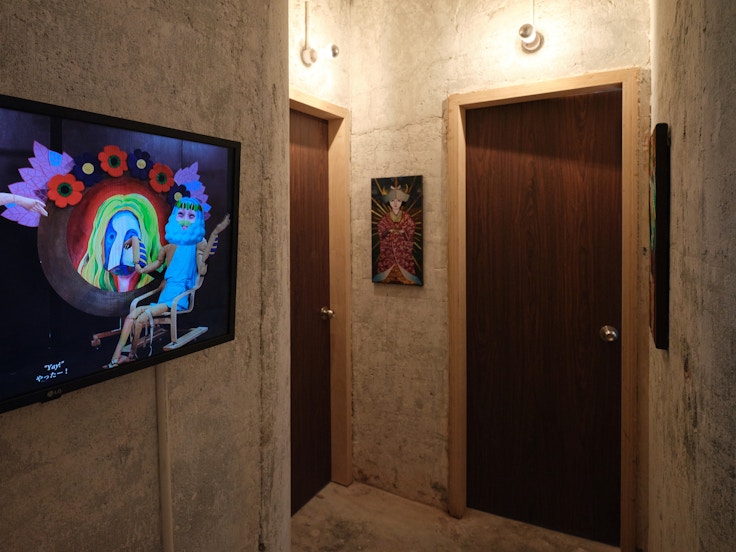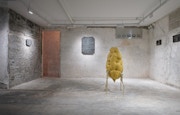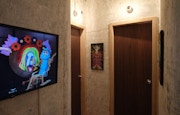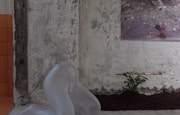香港の銅鑼湾(コーズウェイベイ)にある地味な商業ビルの最上階にひっそりと佇む「Property Holdings Development Group」(以下、PHDグループ)は、2022年初頭にオープンした新進の現代アートギャラリー。共同設立者は、デ・サルテ・ギャラリーの元ディレクター、ウィレム・モールズワースと、アートライターで評論家、『ArtAsiaPacific』の元編集長のイサベル・チェンの夫妻だ。
覇権主義的で均質化されたコマーシャルアートの世界において、PHDグループは、市場主導型のアートと批評的な関わりのあいだに自分たちを位置づけることで、その存在を際立たせている。もともとチェンの亡き祖父とふたりのビジネスパートナーが所有していた会員制のプライベートクラブだったこのギャラリーは、3000平方フィートのスペースを「改築・更新」したもの。ここでは設計、家具、記念品、春画や硬貨のコレクションなど、70年代のクラブの全盛期から多くの特徴を現代に受け継いでいる。
──PHDグループのアイデアはいつ、どのようにして生まれたのでしょうか?
ウィレム・モールズワース(以下、ウィレム) ごく自然に生まれたもので、ギャラリーを開くことを人生の野望のひとつとして掲げていたわけではありません。私は自分のキャリアにおいて、ギャラリーを開くということがいかに困難なことであるかを知っているので、「絶対にやりたくない」といつも言っていたくらいです。でも、デ・サルテ・ギャラリーでの仕事が終わり、イサベルが小説を書き始めて1年ちょっと経った頃、自分たちが何をしたいかという話をしはじめました。

私はイサベルと一緒に仕事をするのがとても好きで、ニューヨークで同僚として出会ったのが最初です。私たちは、以前から行っていた「Suitcase Institute」プロジェクト(編集部注:スーツケースで作品を巡回展示するプロジェクト)を発展させようと考えましたが、非営利のモデルでは、柔軟性や主体性がないため、私たちがやりたいことや達成したいことに対応できないことに気づきました。こうして、アートギャラリーをオープンするという、率直に言って予想外の結論に至ったのです。
──あなたにインスピレーションを与えたギャラリーやプロジェクトスペースはありますか?
ウィレム 香港のEmpty Galleryは間違いなくそのひとつで、彼らは非常に異なったことを行っていると思います。もうひとつ、私たちが長いあいだ尊敬している地元のギャラリーHanart TZです。彼らのプログラムは本当に興味深く、有意義な方法で香港に根ざしており、PHDグループと共鳴しています。
──おふたりとも香港、ニューヨーク、ロンドンに住んで仕事したことがありますが、なぜ香港でギャラリーを開くことにしたのですか? そしてそれはどんな意味があるのでしょうか?
イサベル・チェン(以下、イサベル) 香港は、私たちがもっとも強い芸術的なネットワークを見つけた場所です。ギャラリーや美術館、キュレーターだけでなく、アーティストやほかのアート関係者、友人など、あらゆる人たちとの。私たちは香港で様々な仕事をしてきましたが、ほかの場所にはない、芸術的なコミュニティのいち員として一緒に成長してきた感覚があります。以前、ロンドンやニューヨークにいたときよりも、ここでは強いつながりを感じているのです。

ここは新しいギャラリーにありがちな金銭的な制約がなく、家族のスペースであることも大きな要因のひとつです。心配事はありますが、このスペースは私たちの活動をスタートさせるのにとても役立っていると思います。運命や宿命とは言いたくないですが、何か神話的なものがありますからね。ウィレムと私は、ここに至るまでに本当によく働いてきたと思いたいのですが、何か特別なものへの鍵を授かったように思えました。
ウィレム 私は香港に住んで6年になります。この場所がとても好きで、イサベルが話したように、コミュニティと深いつながりがあります。私たちは深刻なトラウマを経験しており、それがよりいっそう私たちを深く結びつけています。香港はクリエイティブな面で多くのものを提供していますが、それが国内外で十分に評価されているとは思えません。それを是正していきたいのです。
──最初からクラブハウスにこだわりがあったのですか?
イサベル 最初からこの場所が候補だったわけではありません。じつは、自分たちのアパートなど、ほかの実験的な選択肢も考えていたのです。しかし、クラブハウスの改修を担当したボー・アーキテクツ(Beau Architects)と連絡を取り合い、彼らの協力によって可能性が広がりました。アパートメントギャラリーは香港では以前から行われていましたが、クラブハウスに出会ったことで、香港ジョッキークラブ(編集部注:香港のアートセンター「大館(タイクン)」を運営する競馬の競技団体)とは異なる方法で、とくに遺産や遺跡を保存するという考え方に非常に興味を持つようになりました。彼らが大館で行ったことは美しいことですが、私たちは家族の歴史やオルタナティブな物語を保存するという点で違うことを行っているのです。

──このスペースを最初に手がけたときはどんな感じでしたか?
イサベル 過去10年ほど放置されていたため、多くの問題がありました。最初にこのスペースを見た人のなかで、ボー・アーキテクツはとても熱心で、その熱意が私たちを説得しました。たしかに改修中は死ぬかと思うような日もありましたね。しかし、死は一種の再生であり、このプロセスを通じて、私たちはこの空間について多くを学び、とても親密に感じるようになりました。
ウィレム 決して良い状態ではなかったのですが、私たちを呼び続ける何かがあったのです。
──亡き祖父の遺品やオブジェ、アートのコレクションを収めた魅力的なビデオを制作され、PHDグループのソーシャルメディアで見ることができますね。コレクションの選別とアーカイブのプロセスについて詳しく教えてください。
イサベル 明らかに傷んでいたり、放置されていたものが多かったので、そのプロセスを表現する言葉としては「苦痛」があります。しかし、ウィレムにとっては素晴らしい再発見の瞬間だったようです。私はすべての品物を調べることに消極的でしたが彼はとても熱心、という緊張関係がありました。ウィレンがすべてやってくれたので、私は祖父のコレクションを鑑賞することができました。
ちょうどその頃、大館で「Portals, Stories, and Other Journeys」という展覧会を見ました。この展覧会は、アジア・アート・アーカイブ(AAA)がキュレーションしたもので、香港のアーティスト、故夏碧泉(ハ・ビック・チュエン)(1925〜2009)の個人的なアーカイブをもとにしています。この展覧会は、誰かのライフワークをアーカイブし、それを見ていくことの意味を問うており、私にとって非常に意味のあるものでした。また、AAAは『The Orpheus Double Bind: What Can Writing Save?』という、人物や歴史的な出来事の記憶を蘇らせることをテーマとした本も刊行しました。クラブハウスが元々どのようなものであったかの写真がなかったため、各部屋の環境を再構築し、現代美術の展示という目的のためにアップデートしながら適応させる必要がありました。このスペースで行われたすべてのデザインとデシジョンは、非常に計画的であり、私たちはつねにこのスペースのアイデンティティについて考えていました。
ウィレム 適応のプロセスが、私たちがこの場所をどのように構想してきたかの鍵になります。集い、共有する場としての機能を維持するために、壁を取り払うことも、新たに壁を立てることもしませんでした。なるべく手を加えず、既存のかたちを生かしたのです。

──アーカイブ、保存、個人的な関係といった考え方は、アーティストやコレクターとの仕事の進め方にも反映されているのでしょうか?
イサベル 私たちが意図的に行っているわけではありませんが、私たちのアーティストは皆、非常に研究的な活動をしています。また、彼らの多くは集団的な実践やコラボレーションという考え方に深い関心を抱いており、私たちもそれに非常に興味を持っています。これは、香港のアート・コミュニティを反映したものだと思います。
ウィレム プログラムではそれを積極的に取り入れるようにしています。私たちは2組のアーティストを取り扱っていますが、一緒に仕事をするアーティストの多くは、ほかの人と一緒に作品をつくることに興味をもっています。PHDグループという名前も、ダジャレではありますが、自分たちを集団のようなものだと考えていることを表しています。そのことを意識して活動していきたいと思っています。
──コマーシャルギャラリーのなかで、どのように有意義な空間をつくるのでしょうか? アーティスト、コレクター、そして一般の人々のあいだには、アートの意味や消費のされ方について、本質的な緊張関係があるように感じますが。
イサベル これは興味深い質問で、私たちもギャラリーをオープンすると決める前から話していたことです。不安は避けられないと思いますが、私たちふたりの現場での経験から、その不安と課題を面白い方法で解決することができると思います。それはつまり、居心地の悪い会話をすることです。例えば、香港のアーティスト、ミシェル・チューの月経血で構成されたテキスタイル作品を、ギャラリーのなかでもっとも販売志向の強い空間であるビューイング・ルームに展示しています。コレクターのなかには、この作品に嫌悪感を抱いたり、気分を害したりする人もいて、不評を買ったこともありました。そこで私たちは、作品を撤去したり、彼らに同意したりするのではなく、彼らと会話をし、その場にとどまることにしたのです。というのも、その空間に長くいればいるほど、素材自体に不快感はないことに気づくからです。月経血とは何かという先入観や、女性とその身体をめぐる社会的な期待があるだけなのです。

これは、私たちがどのようにアプローチしているかを示す良い例だと思います。コレクションにふさわしくないと思われる作品や、多くの人が容易に消費できない作品もありますが、私たちはそれに挑戦する覚悟があります。難しいことなので、いつも楽しんでいるとは言いませんが、その違和感にかかわり、できれば人々がアイデアを議論するプラットフォームになりたいと思っています。
ウィレム マーケットに対してもっと問いかけ、あらゆることに疑問を投げかけようとすることです。私たちは虫眼鏡を掲げて、「どうしたらもっとうまくできるのか」「どうしたらこれと関わり、コレクターとそれについて会話ができるのか」と問いかけたいのです。また、ギャラリーには「The Study」というスペースがあり、コマーシャルギャラリーの伝統的な構造とは別に、人々が集まり、会話し、アイデアを共有できるような場所となっています。
イサベル 香港のカフェの歴史──2019年にパラサイトで行われた瞿暢(チュー・チャン)がキュレーションした「Café do Brasil」展で探求された──と同様に、一種のラディカルな社会空間ですね。もちろん、私たちはコマーシャルギャラリーですが、商業的な主導権と批評性のあいだになんらかのコラボレーションができればと思っています。
──今後の展覧会やプログラムの計画について教えてください。
ウィレム 現在開催中の「Virtue Village: Village Porn」展の後、夏にはイサベルの祖父の古い春画コレクションを展示し、9月には笹岡由梨子の新作ビデオとペインティングを展示する予定です。カーニバルのような雰囲気で、メンタルヘルスと魚の頭をテーマにした展示になります。笹岡のビデオでは、彼女が食べた魚の頭を使って人形やパペットをつくり、魚に新しい生命を与える方法を紹介しています。この後、11月にはディラン・デローズ、翌年にはゼン・マーラー、ミシェル・チューを紹介する予定です。

──おふたりのアプローチの仕方で似ているところ、あるいは違うところがありますか?
ウィレム 私たちは、ある物事のとらえ方、目標、道徳観という点で、とても同じ考えを持っていると思います。ただ、彼女は私よりもずっと雄弁です。私は文章を書こうとしたことがありますが、彼女と比較すると、物足りない!共同設立者として彼女のクリエイティビティを借用することは、本当に素晴らしいことです。私たちはふたりともクレイジーなアイデアを持っており、それを一緒に解決することができるのです。
イサベル 同じビジョンを持っていても、アプローチがまったく違うのは、彼がギャラリーや表舞台で活躍した経歴を持っていることも影響しています。いっぽう、私は裏方でじっくりとコンセプトやテーマを考えるのが好きです。私は内向的で、初対面の人と話すとすぐに疲れてしまうので、ウィレムがギャラリーの表舞台に立つことに抵抗がないのは嬉しいことです。たしかにぶつかる日もありますが、私たちはこのプロジェクトに力を入れているので、いつもそれを乗り越えようとしています。それは、ギャラリーが決してたんなる一枚岩ではなく、ひとつのビジョンやひとつのモデルのような空間であるということでもあると思うのです。つねに変化し続け、そこにアーティストや友人などが加わると、進化する共同作業のようなものになるのです。
ウィレム 数ヶ月前までは、人に助けやアドバイスを求めることに抵抗があったのですが、いまではいつもそうしています。
イサベル フィードバックを与えたり、受けたりするプロセスは、学問やメディア業界ではとても一般的なことです。ギャラリーの世界ではもっと競争的で、アイデアを共有することはあっても競争的な側面があるように思います。

──最後に、PHDグループの運営でもっとも驚いたこと、予想外だったことを教えてください。
イサベル まず、ギャラリーを開くというアイデアがまだ頭のなかにあったとき、友人や味方だと思っていた人たちからネガティブなフィードバックを受け、実行に移せなくなりそうになったことがあります。ふたつ目は、自分たちでも驚くほど、このプロジェクトにこだわり続けたことです。3つ目は、ギャラリーが真剣な場所であること、そしてその空間に対する私たちのコミットメントをほかの人が見てくれることが、とても素晴らしいことだったということです。美術館の学芸員やアーティスト、コレクターが私たちの努力に感銘を受け、空間の細部にまで私たちの思いが込められていることを喜んでくれたことは、人生を肯定してくれるような気がしました。
ウィレム そうですね。もうひとつ驚いたのは、私たちがどれだけ自分たちを追い詰めたかということです。私たちふたりは、これまでも一生懸命に仕事をしてきましたが、この空間のリノベーションは、言葉では言い表せないほど大変なものでした。
- 1
- 2



































